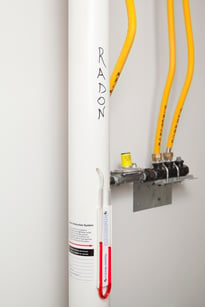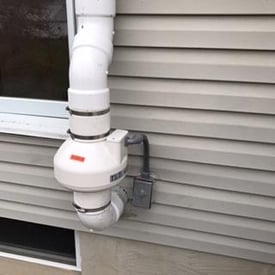When it comes to Radon Gas, you want to be sure you're not living with dangerous levels in your home. 
Radon is the second leading cause of lung cancer in the United States, and the leading cause for non-smokers has home buyers concerned, and rightly so.
Many people who are having a new home built will just have a builder-installed passive radon system installed, and they will be good to go.
Unfortunately, this is not always true and can lead the new home owner's into thinking
they have a system that is working to eliminate the hazardous gas from their home, when in reality, it may only be reducing the levels by 50%.
Want more information about different radon mitigation systems? Read our blog post: “Radon Mitigation System Installation Differences.”
Table of Contents
Schedule a Free Radon Mitigation Quote
Here is what you can do to ensure the safety of yourself and your family if a Passive System was installed:
Perform a Radon Test
Many people who have a passive radon system installed while their home is being built, will never actually have a radon test performed.
If this is the case, there is no way to know if your passive system is even working at all.
Contacting a licensed company to perform a radon test may set your mind at ease, or make you aware of a potential problem.
If your radon test comes back elevated, it may mean your passive system isn't working or that your radon levels may be much higher if it were not installed.
According to the EPA, passive radon systems are usually not as effective at reducing high radon concentration levels in a home. The systems will typically reduce radon levels to some extent, but may not reduce the levels below the EPA 4.0 action level.
If your test comes back elevated, you will need to contact a licensed Radon Mitigation company to add a ventilation fan onto your passive system to further reduce the concentration levels in your home.
Add a Ventilation Fan
When a radon v ventilation fan is added to a passive system, it then becomes an active radon mitigation
ventilation fan is added to a passive system, it then becomes an active radon mitigation
system.
Active radon mitigation systems are guaranteed by Radon Eliminator to reduce the radon concentration levels in a home below the EPA recommended action level of 4.0.
An active system works to vent the radon gas up from beneath the foundation of the home to the outside.
Contact a Licensed Radon Mitigation Company
When a home is being built, more than likely the builder who installs the passive system will not be a licensed radon mitigation specialist.
When converting a passive system to active, you can verify that the company you hired is licensed by visiting The Ohio Department of Health.
A licensed company will be able to ensure that your system is up to code, installed efficiently, provide a warranty, and a guarantee that the levels are brought below the 4.0 action level.
Radon Eliminator has a team of licensed radon testing and radon mitigation specialist who will find out if your home is safe by conducting a radon test, if the levels come back elevated, they will install a ventilation fan to ensure the levels are lowered.
To speak with a specialist to see how we can help you, click below.





